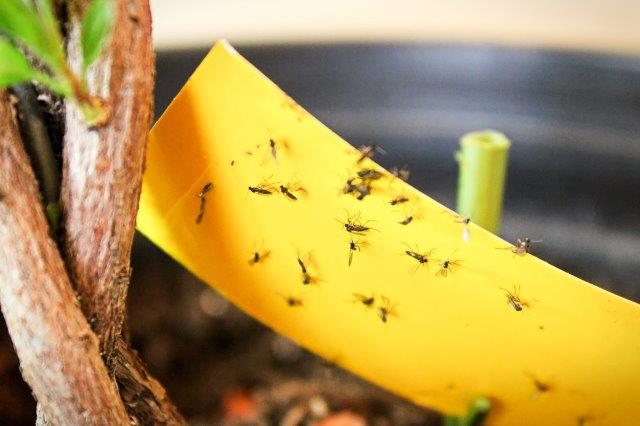Also known as Carrot rust fly, carrot fly, or carrot root fly Psila rosae is an incredibly annoying pest to the garden. They don’t physically cause damage as adults, however their larvae feed on the roots of many garden plants.
The Carrot rust fly favors cool and moist conditions. If your soil tends to hold water well it is highly recommended that you utilize yellow sticky cards to identify the severity of a population in your garden.
How to Get Rid of Carrot Fly
- Carrot Fly Distribution: Widely around the world anywhere Apium grows
- Carrot Fly Host Plants: Apium crops such as carrot, parsnip, celeriac, hemlock, celery
- Carrot Fly Life Cycle: 8 weeks
- Carrot Fly Eggs Per Lifetime: ~250-350
- Carrot Fly Control: Area crop harvest rather than individual, granular insecticides
- Carrot Fly Predators: Parasitoids, Chorebus gracilis, Eutrias tritoma, Aleochara sparsa
- Most Common Carrot Fly in North America: Common Rust Fly (Psila rosae)

What Do Carrot Flies Look Like?
As larvae Carrot Rust Flies first appear as colorless maggots which gain a white/yellow coloring over a month.
They are approximately 0.12 mm to 0.25 mm long. They first start boring into roots in the late spring after overwintering. During their pupation period of approximately 25 days they appear brown as they reside near the roots in the soil.
Adults emerge in May-June and measure about 5mm long. They have red eyes, an orange head, slender bodies with a black abdomen and thorax, yellow legs, and dark transparent wings that open to 12.7mm.
Carrot Root Fly Damage
It is the Carrot Rust Fly larvae that do the damage to garden crops as they create tunnels throughout the root of the plant. This creates a problem for identification as the surface is left looking happy and healthy.
If you are able to identify wilting and stunted growth from above, quickly take action. Underground the maggots chew through the roots leaving rust colored frass damaging many root crops. In the case of carrots the portions of the carrot without these trail markings is still safe for consumption, though it appears less appealing.
Overall crops can become distorted, stunted, scarred, and yellowed. These underground symptoms can lead to yield reduction and eventual death.

What Do Carrot Flies Eat?
Adult Carrot Rust Flies are attracted to the scent of their host plants. Their main hosts include umbelliferous crops which are those with umbrella shaped lacy flowers.
The most common being carrots, celery, parsley, fennel, coriander, dill, cumin, among many others. While adults have rasping sucking mouths they do not cause any damage in the garden and rather take shelter in hedges.
Within the garden the larvae are the damage causing pests with their rasping chewing mouths. They burrow through the soil to the roots of the host plants where they chew, creating tunnels.
Carrot Fly Larvae
Carrot Rust Fly eggs are tiny measuring only 0.6-0.9 mm long and 0.15 mm wide.
They are laid on the soil surface or just barely under the base/crown of plants in the early spring to late summer. With extremely short life cycles you may have up to three generations a year. These generations would hatch in the early spring, summer, and fall.
How to Get Rid of Carrot Fly

Carrot Rust Flies are incredibly hard to completely get rid of, but there are several methods that can be applied to prevent and reduce their numbers.
To start, plant your crop after mid-june as this is the peak egg laying season. Supplement your planting with a granular insecticide that is placed in the furrow to avoid larval feeding.
During harvest the best measures you can follow are to work in a grid pattern removing all of the crop in squares rather than individually to prevent the spread of the flies.
It is also recommended that all crop residue is removed post harvest. Crop rotations can also be used to prevent population build up. During the growing season utilize floating row covers to prevent egg laying and adult presence. Sticky traps can also be used to monitor the population levels as well as capture adult flies.
Carrot Fly Pesticide
- Dish Soap and Water - 2 tbsp to 1 quart water
- Carrot Fly Vinegar Spray - 1 part vinegar to 3 parts water
- Organic Neem Oil Spray - 1 tsp neem oil and 1/4 tsp dish soap to 1 quart water
- Castile Soap - 1 tbsp to 1 quart water
- Bacillus thuringiensis (Bt) - Store bought spray consisiting of natural soil-borne bacteria
- Spinosad Spray - Natural soil bacteria effective in treating several garden pests












